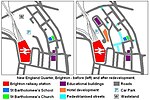St Bartholomew's Church, Brighton
19th-century Church of England church buildingsAnglo-Catholic church buildings in East SussexChurch of England church buildings in Brighton and HoveChurches completed in 1874Grade I listed buildings in Brighton and Hove ... and 1 more
Grade I listed churches in East Sussex

St Bartholomew's Church, dedicated to the apostle Bartholomew, is an Anglican church in Brighton, England. The neo-gothic building is located on Ann Street, on a sloping site between Brighton railway station and the A23 London Road, adjacent to the New England Quarter development. It is notable for its height – dominating the streets around it and being visible from many parts of the city – and its distinctive red-brick construction.
Excerpt from the Wikipedia article St Bartholomew's Church, Brighton (License: CC BY-SA 3.0, Authors, Images).St Bartholomew's Church, Brighton
Ann Street, Brighton Round Hill
Geographical coordinates (GPS) Address Nearby Places Show on map
Geographical coordinates (GPS)
| Latitude | Longitude |
|---|---|
| N 50.830833333333 ° | E -0.13722222222222 ° |
Address
St Bartholomew's CofE Primary School
Ann Street
BN1 4GP Brighton, Round Hill
England, United Kingdom
Open on Google Maps











